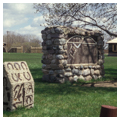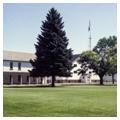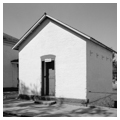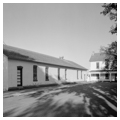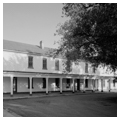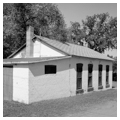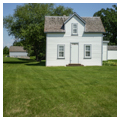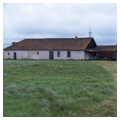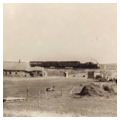Buildings and landscapes molded by diverse cultural groups are among the richest parts of North Dakota’s heritage. Over hundreds of years, Native American population groups developed sustainable strategies for living in the harsh context of the northern Great Plains. Domed earthlodges and agricultural landscapes synthesized by the Mandan and Hidatsa on the Missouri River bottomlands embody a remarkable reconciliation of culture and context. Little evidence remains of the place-making of Assiniboine or Cree people in the northeastern parts of the state, but their contacts with French and Métis cultures helped shape the way the land was occupied. The architecture and mobility of the Lakota Sioux Nation were suited to actively resisting the advance of manifest destiny imposed from sites like Fort Abercrombie (RI6) and Fort Totten (BE3). A third distinct Native American experience is reflected in the settlements of Anishinabe Ojibwe or Chippewa people in the Turtle Mountain region.
Immigrants from diverse cultural backgrounds imposed their traditions and prior experiences. Canadians of Scottish, English, and French backgrounds established communities and architecture in the northeastern parts of the state, and New Englanders projected their patterns of settlement onto an unfamiliar landscape. The relatively late date of settlement and statehood attracted groups accustomed to scraping a hard living out of hostile terrain, including German Russians; Scandinavians of Swedish, Norwegian, and Icelandic descent; and Scots-Irish. Smaller enclaves formed of people from eastern European and Middle Eastern cultures. Jewish agricultural societies aggressively promoted the establishment of Jewish enclaves in northeastern North Dakota. The interplay, assimilation, and distinctiveness of these diverse traditions make up a fascinating architectural landscape. From 1885 to 1915, there was relatively little mixing of the cultural traditions and social practices of the various immigrant groups. Settlement patterns and rural education tended to maintain cultural and ethnic enclaves. Today, remnants of this varied heritage have been preserved through reconstructed buildings that aid understanding of the way this chronology unfolded. Museums and sites such as Icelandic State Park (PB7) highlight the architectural experience of several culture groups.
Each culture was characterized by its use of distinct materials, building types, and details. German Russians, German Hungarians, and Bohemians brought their tradition of mass wall houses and connective house house-barns (see HT6) to places like Mott, Manning, Fairfield, and New Hradec. Woodcraft and an emphasis on literary learning are embodied in country schools handcrafted by Swedish and Norwegian American immigrants, particularly in the northeastern parts of the state. Places of worship affirm the religious values of different faiths. Distinctive architectural traditions are associated with some of the least known cultural enclaves, like those of Icelandic Americans and Lebanese American Muslims, who built an unfired clay earthen mosque at Ross, of which nothing survives. William C. Sherman and Playford V. Thorson’s Plains Folk: North Dakota’s Ethnic History 1988 provides an excellent perspective on building traditions that have subsequently disappeared.
Writing Credits
If SAH Archipedia has been useful to you, please consider supporting it.
SAH Archipedia tells the story of the United States through its buildings, landscapes, and cities. This freely available resource empowers the public with authoritative knowledge that deepens their understanding and appreciation of the built environment. But the Society of Architectural Historians, which created SAH Archipedia with University of Virginia Press, needs your support to maintain the high-caliber research, writing, photography, cartography, editing, design, and programming that make SAH Archipedia a trusted online resource available to all who value the history of place, heritage tourism, and learning.


